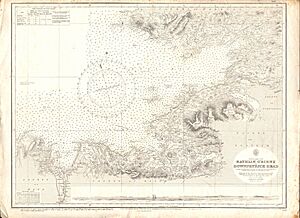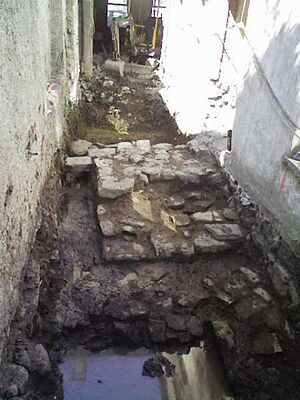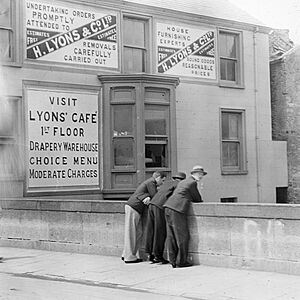History of Sligo facts for kids
The town of Sligo was founded in 1243 AD by the Norman knight Maurice Fitzgerald and Fedlim O'Conchobar, the Provincial King of Connacht. The Normans were a group of French-speaking knights. Their influence in Sligo lasted for about 60 years.
Around 1310, after a time of Irish cultural strength, the town became part of the Gaelic world. It grew along the Sligeach (Garavogue) river. The O’Conchobhar Sligigh family ruled it. Sligo was part of the Irish area called Cairbre Droma Cliabh. It was also part of the Gaelic group of lands known as Iochtar Connacht (Lower Connacht). This continued until County Sligo was created by the English Lord Deputy Henry Sidney in 1561.
Contents
Sligo's Early History
What Does 'Sligo' Mean?
The name Sligo comes from the Irish word Sligeach. This means "full of shells." It refers to the many shellfish found in the river's mouth. There were also large piles of shells along Sligo Bay. At first, the name was only for the river. Later, it was used for the town and then for the county in 1561.
Some people believe 'Sligo' comes from 'Sli da Atha'. This means "the way of the two fords" (river crossings).
Ancient Times in Sligo
People have lived around Sligo Bay since about 8000 BC. This is shown by old shell piles from the Mesolithic (Middle Stone Age) period. Sligo was also a very important place. It was located in a narrow space between Lough Gill and the sea. It was also on the main path between the areas of Ulster and Connacht. Sligo was a natural meeting point where many paths crossed.
The area was very busy between 5000 and 4000 BC. Many ancient sites from the Neolithic (New Stone Age) period surround the town. Some are even inside the town itself. The oldest known ancient enclosure in Britain and Ireland is at Magheraboy.
Ancient Greek and Roman traders knew about this area. It was marked on Ptolemy's map from the 2nd century AD as the town of Nagnata. This was the only town shown on Ireland's west coast by Ptolemy. Traders might have been interested in the silver and lead mines nearby.
Early Christian Sligo
The area where Sligo town now stands might have been a forest in the 5th century. An old story says that Saint Patrick predicted people would move from an early church site to the current town location.
The local Irish area was called Cairbre Drom Cliabh. It was also known as "The District of Contention." Many religious places were built here during the early Christian period. The Columban monastery at Drumcliff was the biggest settlement from 561 AD. Today, you can see a High Cross and a round tower there.
By the early 12th century, a bridge and a small settlement already existed where Sligo town is now.
Norman Influence in Sligo
When Norman knights invaded Connacht in 1236 AD, they brought new ways of building towns. These knights, who spoke French, were called Galls by the Irish. They introduced a European town style based on trade and money.
Sligo was perfect for the Normans. It was near the sea and had a safe port. This was important for their military plans, as they used ships to bring supplies and soldiers.
The Normans used the disagreements between Irish groups to their advantage. Maurice Fitzgerald, a Norman leader, ordered a castle to be built in Sligo. He made Fedlim O'Conchobar, the King of Connacht, pay for it. Maurice used this castle to attack other Irish lands.
The Annals of Connacht from 1245 AD say:
The castle of Sligo was built by Mac Muiris FitzGerald, Justiciar of Ireland, and by the Sil Murray. For Fedlim O Conchobair, was bidden to build it at his own cost and to take the stones and lime of the spital house of the Trinity for the building, though the Justiciar had previously given that site to Clarus Mag Mailin in honour of the Holy Trinity.
Fighting over Sligo castle happened often from 1245 until it was destroyed in 1691. We don't know the exact spot of the castle today, but it was likely near the current City Hall. This area became known as Castlequarter.
The Sligo Abbey (a Dominican friary) was founded in 1253. Houses and shops soon grew up around it. People provided services or sold goods to the monks. This area became known as Abbeyquarter. The Dominicans were monks who relied on donations and preached to the poor.
In 1257, Maurice Fitzgerald was badly hurt in a battle north of Sligo. The Normans tried many times to keep control of Sligo but were finally pushed out around 1315. However, they had already set up the basic layout of modern Sligo. The main street with its market area is typical of Norman town designs. The narrow plots of land behind houses also show Norman planning. They also brought their trade connections with England, France, and Spain. This helped Sligo become an important port for wine.
Sligo in the Gaelic Era
Sligo is special because it was the only Norman town in Ireland to stay under Irish Gaelic control for a long time. This was from about 1300 to 1600 AD. During this time, the town became the main center of the Gaelic group of lands called Íochtar Connacht.
Sligo grew and traded a lot in the 14th and 15th centuries. It traded with Galway and with French, Spanish, and English merchants. Herring fish was very important. An old song from the 15th century says:
"Herring of Sligo and salmon of Bann, Has made in Bristol many a rich man".
Sligo was a busy port, sending out fish, wool, animal hides, and wood. It brought in wine, salt, and iron. Even saffron and indigo were imported for dyes. The income from the port was very valuable and often fought over by local families.
Several wealthy merchant families, like the O’Creans, had large houses near the abbey. The Annals of the Four Masters reported:
"The town was burnt by O Domnaill, which was a pity buildings both of stone and wood were magnificent."
Horse races were held in the town in front of the castle. Sligo castle was considered very strong by English leaders.
Elizabethan Conquest and Changes
In the late 1500s, the English government in Dublin wanted to control Sligo. It was a key location for anyone trying to rule the northwest of Ireland. Sligo was caught between three powerful groups: the Earls of Clanricard, the O'Donnell family, and the English Crown. The town was destroyed during the Nine Years' War.
In 1567, Domhnall O'Conchobar made a deal with Henry Sidney. He agreed to pay rent for protection. This is when Sidney created County Sligo. As part of the deal, an English sheriff and court system were allowed in the county. However, several sheriffs were killed trying to enforce these new rules.
In 1588, three ships from the Spanish Armada were lost off the coast near Streedagh beach. The shipwrecks were found again in 1985. A survivor, Captain Francisco de Cuellar, wrote about what happened.
Sligo in the 1600s
Sligo was given a special charter in 1613 by King James I. It became the main town of the new County Sligo. This started a new period as an English administrative center. The new sheriff, Sir Roger Jones, set up the county government near the abbey. Later, a new fortified tower, Jones castle, was built. The current courthouse is in this same area.
English slowly became the main language in town. However, Irish remained the main language in the county until the late 1800s.
The 1641 Rebellion
Local Irish leaders were unhappy with the new English power. They rose up in the 1641 rebellion. This was the last time Irish Gaelic culture fully controlled the region.
During this time, some Protestant settlers in Sligo were put in jail for their safety. Sadly, they were later killed by a mob.
Frederick Hamilton attacked the town, burned the abbey, and killed the monks. The government built a new stone fort near the old castle. They also built an earthen fort called the Green fort on a hill north of town. Forts were also built at the entrance to Sligo's shipping channel to protect the route.
Wars of the Three Kingdoms
Sligo changed hands five times during the 1688-1691 wars between the Jacobites and Williamites. The town was defended by the soldier Henry Luttrell. The Jacobite forces in Sligo were led by Sir Teague O'Regan. Patrick Sarsfield later took the town back.
A unique event happened during the siege of Sligo. A siege tower, called a "sow," was used to attack the stone fort. This was the last time such a tower was recorded in Britain or Ireland. It didn't work well because its sides were not strong enough against musket fire.
Even with the wars, Gaelic culture stayed strong in the area. A book of poems, Leabhar Cloinne Aodha Buidhe, was written in Sligo in 1680.
Sligo in the 1700s
In the 18th century, powerful landowners, mostly military men, controlled Sligo. The Wynne family bought a huge estate that included the town. Their home, Hazelwood house, was built in 1722. Other big landowners were the Coopers of Markree and the Gore Booths of Lissadell.
A terrible famine called Bliain an Áir (The Year of Destruction) happened in 1740. It was caused by very cold weather and greatly reduced the population.
Gaelic learning continued in Sligo. Henry MacCarrick, a merchant and scholar, copied important Irish texts.
Sligo was heavily guarded in the 1700s, with four army barracks. In 1794, there was unrest in Sligo due to farmer protests.
During the 1798 Rebellion, the forces of General Humbert marched through Sligo county. They won a battle at Collooney. However, Sligo town did not fall to the rebels. Humbert thought the town had more soldiers than it did, so he didn't attack.
Sligo in the 1800s

Sligo port grew quickly in the early 1800s. Ships carried goods like cork, wine, and oranges.
Many people from the west of Ireland left for other countries. Sligo port was a busy place for people to leave. In 1834, an advertisement offered cheap passage to places like Philadelphia, Baltimore, Boston, and New York. It warned passengers to be careful of dishonest people in Liverpool.
The first steamship arrived in Sligo harbor in 1831. Shipping companies later replaced their sailing ships with steamers. The Sligo Steam Navigation Company was created in 1865.
Sligo gaol (jail) was built in 1818. It was designed in a special way called "panopticon," which allowed guards to see all prisoners.
Disease and Famine in Sligo
Sligo was badly hit by a cholera outbreak in 1832. Up to 2,000 people died. People were very scared and panicked.
Before the Great Famine (An Gorta Mór), County Sligo had a very large population. Sligo was a major port for people leaving Ireland during the famine. In 1846, 11,000 people left through the port. Some of the worst "coffin ships" (ships with many deaths) sailed from Sligo. For example, in 1847, a ship arrived in Canada from Sligo with 440 people. 150 were sick, and 108 had died.
In 1871, about 25% to 50% of people in the county still spoke Irish as their first language. Most people in the county worked in farming. Landowners controlled almost everything.
Sligo grew quickly with new industries in the 1800s. Many public buildings were built, like the town hall and courthouse.
A new law in 1898 allowed more people to vote. This led to a nationalist council being elected. However, most business and government jobs were still held by Protestants. The fight for equal chances became important in the next century.
P A McHugh, a Member of Parliament for North Sligo, was a nationalist and supported workers' rights.
Sligo in the 1900s

Workers' Rights and Strikes
Sligo had many industries, which was unusual for the west coast. This meant that conditions for working people were often very difficult. Many houses and businesses did not have proper sanitation.
Trade unions became strong in Sligo between 1910 and 1914. In 1911, the ITGWU (Irish Transport and General Workers' Union) started organizing workers. Sligo workers won a big strike in 1912. They won again in 1913 when employers tried to weaken the unions. This led to the 1913 Sligo Dock strike. The Trades Council also helped workers get better pay and conditions. By 1914, the ITGWU controlled the docks. In 1913 and 1914, most of Sligo Corporation (the town's government) was made up of Labour members, and an ITGWU councillor became mayor.
Political Changes
In the 1919 election, Sligo was the first place in Britain or Ireland to use a new voting system called PR-STV (proportional representation/single transferable vote).
Sligo: Free State and Republic
When Ireland was divided, Sligo was cut off from parts of its trading area in west Fermanagh and south Tyrone. This affected its trade with places like Enniskillen and Belfast.
Even though Sligo was not directly on the border, it was still affected by the period known as The Troubles in Northern Ireland.




